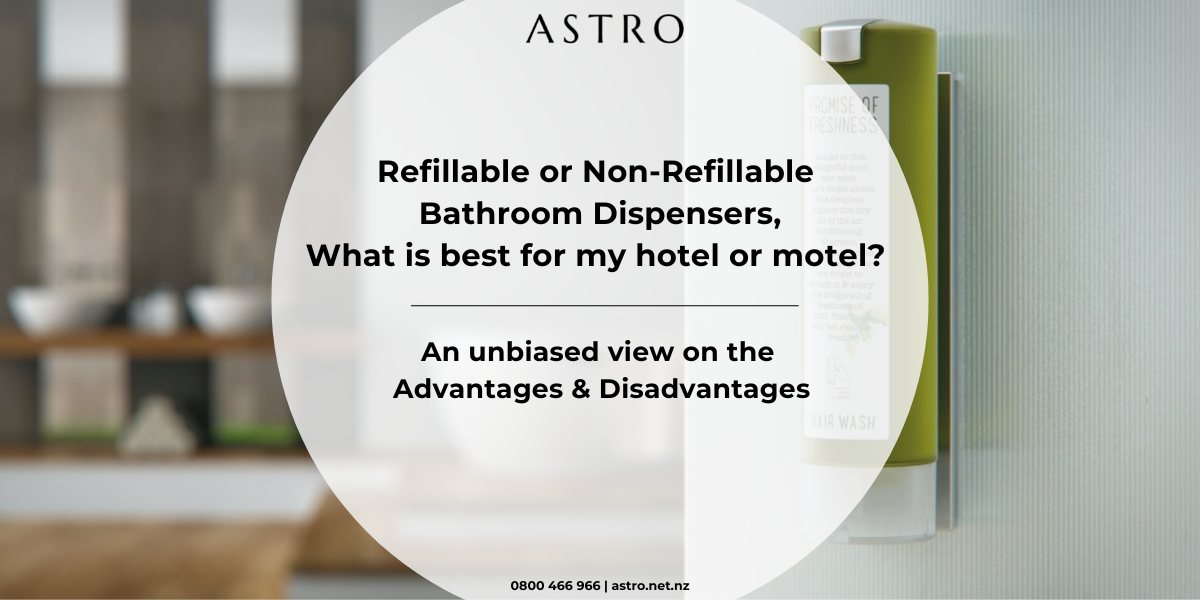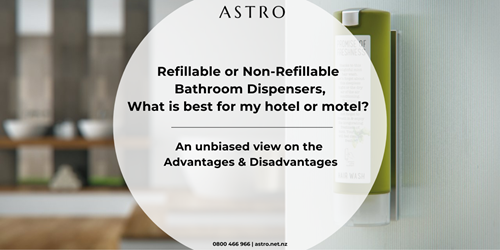Sabrina is a seasoned digital marketing manager with 10+ years of B2B & B2C experience in the tech and SaaS space. She is focused on building and implementing strategies that innovate, create awareness, and generate demand. Sabrina executes brand/product development through strategic alignment, passion, resolute focus, and inspired teams.
What drives the cost of hotel or motel bathroom dispensers up or down?

No one likes to feel like they are throwing their money away, especially in these harsh economic times. Since your hotel or motel’s reputation is enhanced by the quality of its bathroom products it’s important to understand what drives the cost of refillable and non-refillable dispensers up and down.
Here are the top six cost drivers:
1. Country of origin:
When it comes to buying decisions the country of origin or ‘made-in’ has a considerable influence on perceptions, product evaluations, purchasing decisions and costs. For example, dispensers produced in more industrialized countries, such as Europe, where labour costs and raw materials are higher, tend to command higher price premiums over products that have been produced in less industrialized countries, such as China. When you’re working out your budget and what products you would like to have in your hotel it’s always wise to do a price comparison based on where the toiletries are manufactured.
2. Raw materials:
Being a hotel owner, operator or someone who deals with procurement you’re probably aware that globalization has created competition for raw materials. The cost of raw materials is constantly fluctuating due to availability and demand. When there’s a lot of availability a strong demand can help keep prices low since it can encourage competition, but when there isn’t much available paired with a high demand, prices often skyrocket. This means when the cost of raw materials is high it can affect how much a manufacturer can produce at any given time and ultimately what they will charge you as their buyer.
3. Formulations:
Dispenser ranges that are more costly are typically made with higher-quality raw materials and can also factor in fragrance formulations. To meet a specific price point and cut costs amenity manufacturers can dilute or water down the fragrances to make the formulations go further, but this does compromise the quality of the product.
So when you’re picking the perfect signature scent for your hotel guests it’s a good idea to keep this in mind: The more expensive scents tend to have several layers of fragrance that last hours on your guests' skin, which means they will remember their stay for longer. The cheaper options have fewer layers and the scent lasts a shorter period of time. There are also cheaper dispenser options on the market to choose from, but just like the fragrances, the product quality could be compromised to meet the lower price point.
4. Brand Owners:
Brand owners are people or companies that own the brand of the product. If it’s a retail-type brand there are usually royalties involved which means the owner gets a percentage of the revenue generated by the licensed product. In some brand licensing agreements, the royalty rate will go down if a certain sales threshold is met.
5. Shipping Costs:
Shipping costs vary depending on whether you’re importing from overseas vs buying locally, and if you’re using the road, air or sea. To give you some insights the logistics industry is currently experiencing the highest constant peak in increased costs, due to:
- Inflation
- Higher fuel costs from climbing oil prices.
- The war in Ukraine curbing European demand for imports.
- Ongoing pandemic-related delays and closures.
- Non-stop demand for ocean freight and a lack of capacity
- To help combat some of these logistical challenges you can buy locally but be mindful that the shipping costs can be offset by increased labour costs.
6. Volume:
You might be wondering what the trade-off is between volume or batch size vs cost. Generally speaking, buying in bulk is cheaper because the more you buy, the less each unit actually costs you. As an example, if you’re dealing with factories overseas, they typically manufacture large batches or run sizes. Producing considerable volumes allows them to take the product globally which can bring the unit cost down for you. If you’re working with a smaller manufacturer that has a boutique range, their costs will usually be higher because the production processes are typically more manual and volumes are significantly less which means the costs can’t be offset by distributing the dispensers on a larger scale.
7. Dispenser Wall Brackets:
There are many reasons why hotels and motels use dispenser wall brackets – the clean design fits in areas with limited space, the placement offers easy accessibility to your guests, and thanks to the adhesive on the back of the dispenser it can be easily installed or removed from the wall (by the hotelier, not the guest). With so many dispenser options hitting the market you’re probably finding it hard to work out which product and bracket system is best for you.
When choosing your brackets you should consider the country of origin, what raw materials they are made from, stainless steel vs plastic, and if the supplier will add the bracket on as an extra cost or give it to you for free. It’s all about ROI, so whatever bracket system you choose these are the questions you need to ask in order to understand what drives costs up and down.
To help you on your buying journey and stay within your budget check out our recent article: Refillable or Non-Refillable Bathroom Dispensers – What is best for my hotel or motel? Guest satisfaction is everything, along with ROI, and we’re here to help you enjoy long-term savings while elevating your brand with the right dispenser.
Get in touch we’d love to help!
For more information check out


